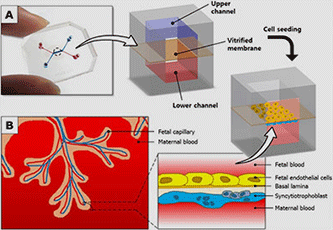
A) The device’s upper (blue) and lower (red) chambers are separated by a semi-permeable membrane. B) Researchers placed maternal cells in one chamber and fetal cells in the other. They then added glucose to the maternal-cell chamber and observed how it traveled through the membrane to the fetal-cell chamber.
Researchers from NIH’s Eunice Kennedy Shriver National Institute of Child Health and Human Development, the University of Pennsylvania, Wayne State University/Detroit Medical Center, Seoul National University, and Asan Medical Center in South Korea combined their expertise in different fields to create a “placenta-on-a-chip” for studying how the mother and fetus tissues interface within the womb.
The device, on a micro level, mimics the structural and functional properties of a real placenta, passing nutrients and oxygen while blocking viruses, bacteria, and other unwanted things from coming through.
Having the ability to study how the placenta regulates the passage of drugs and nutrients, the researchers hope to be able to help design new drugs that are safe for pregnant women as well as understand the physiology of placenta to improve pregnancy management.
The device has a chamber with placental cells and another populated with fetal cells harvested from a human umbilical cord. In between, a mimic of a maternal-fetal barrier was created using human cells that only passes certain compounds through.
Some details according to the study abstract:
“Placenta-on-a-Chip” microdevice was created by using a set of soft elastomer-based microfabrication techniques known as soft lithography. This microsystem consisted of two polydimethylsiloxane (PDMS) microfluidic channels separated by a thin extracellular matrix (ECM) membrane. To reproduce the placental barrier in this model, human trophoblasts (JEG-3) and human umbilical vein endothelial cells (HUVECs) were seeded onto the opposite sides of the ECM membrane and cultured under dynamic flow conditions to form confluent epithelial and endothelial layers in close apposition. We tested the physiological function of the microengineered placental barrier by measuring glucose transport across the trophoblast-endothelial interface over time. The permeability of the barrier study was analyzed and compared to that obtained from acellular devices and additional control groups that contained epithelial or endothelial layers alone.
Study in The Journal of Maternal-Fetal & Neonatal Medicine: Placenta-on-a-chip: a novel platform to study the biology of the human placenta…
Source: National Institutes of Health…
The post Placenta-on-a-Chip to Study Pregnancy, Develop New Drugs Safe for the Fetus appeared first on Medgadget.
